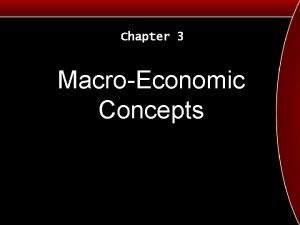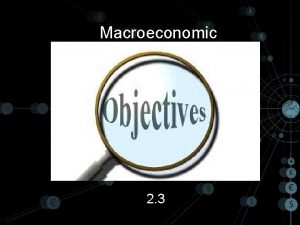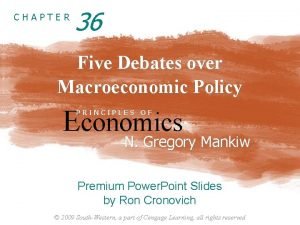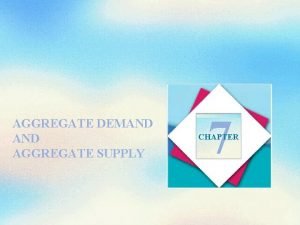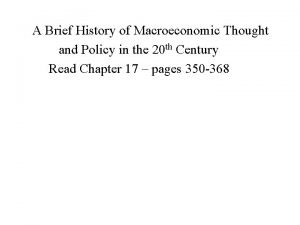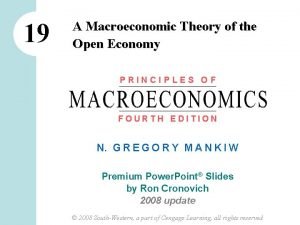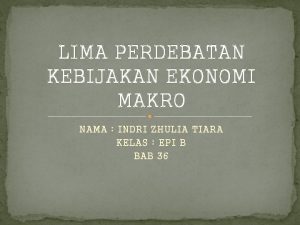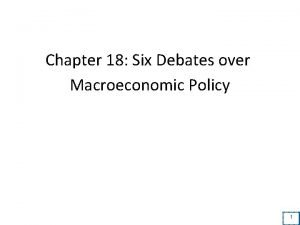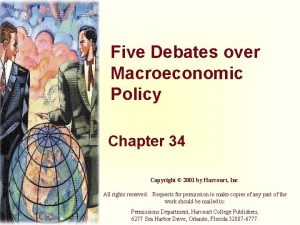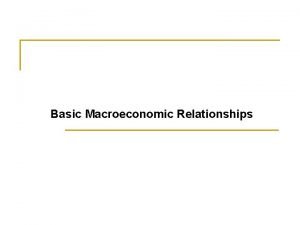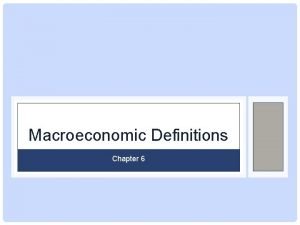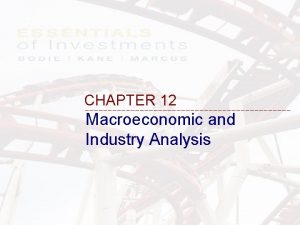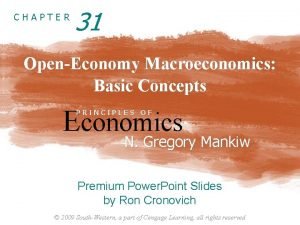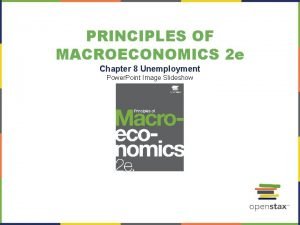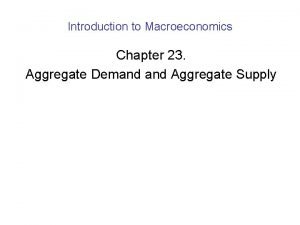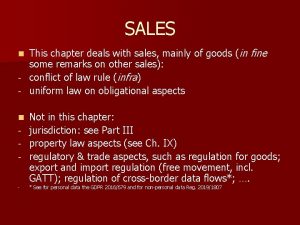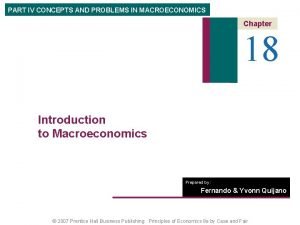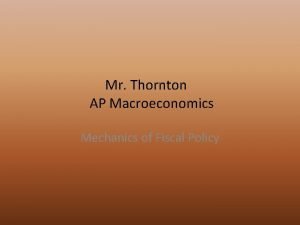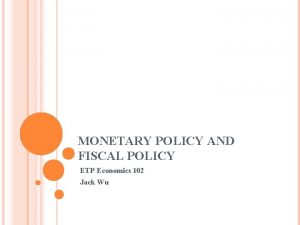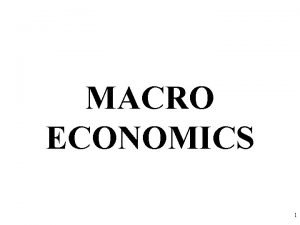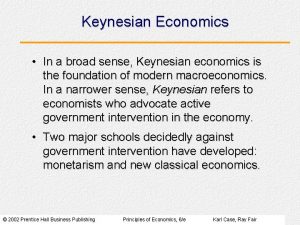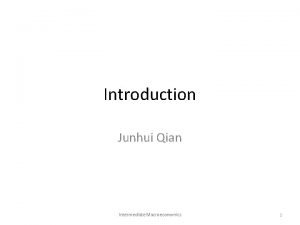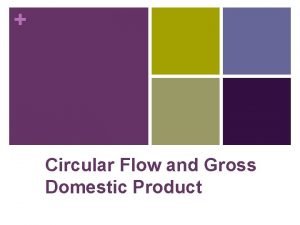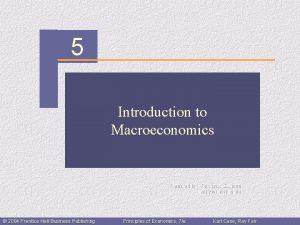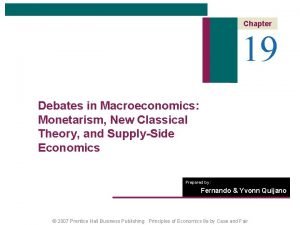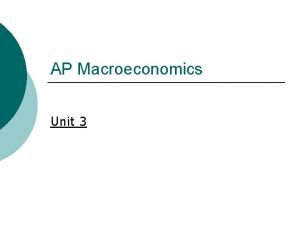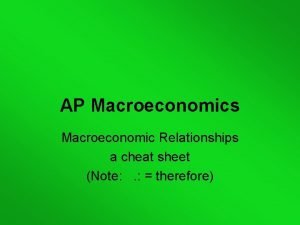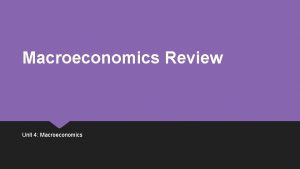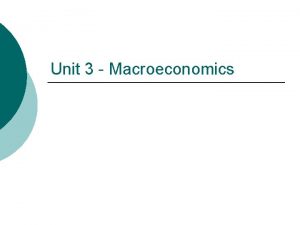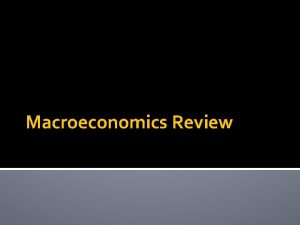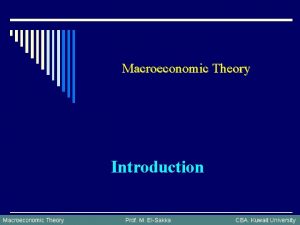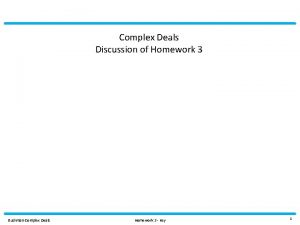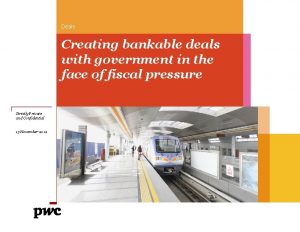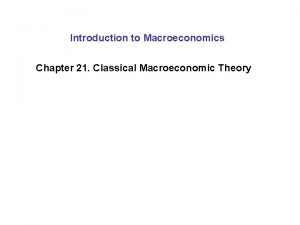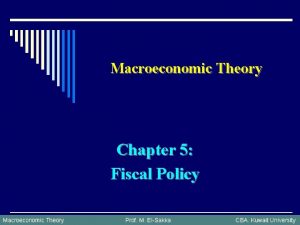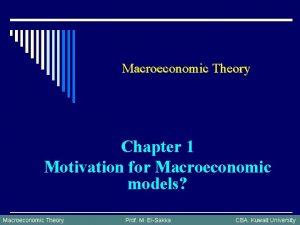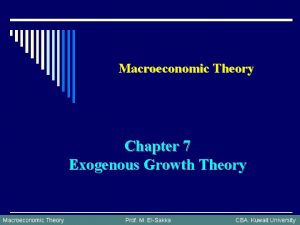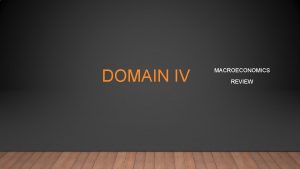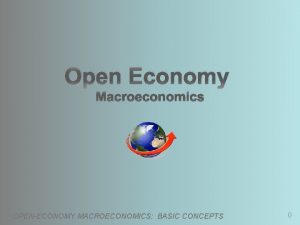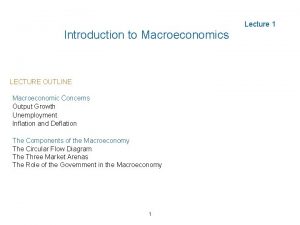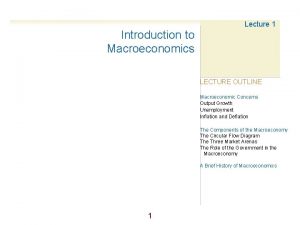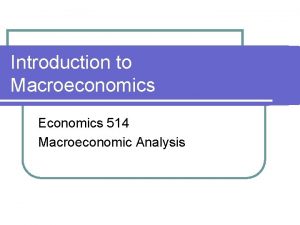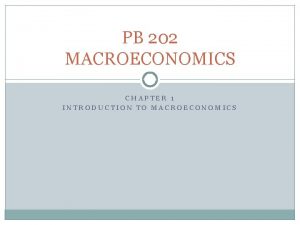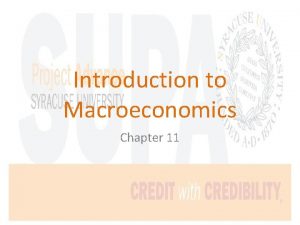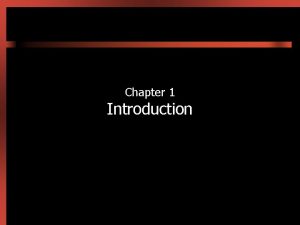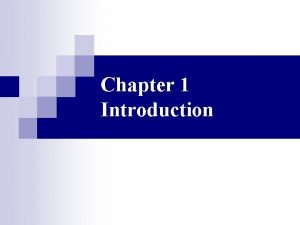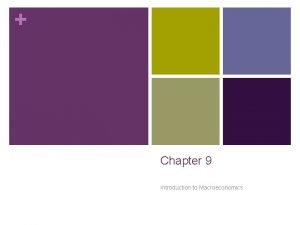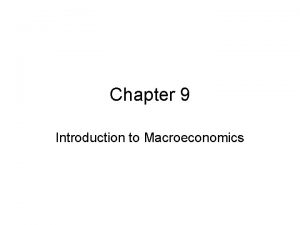Chapter 3 MacroEconomic Concepts Introduction Macroeconomics deals with





































- Slides: 37

Chapter 3 Macro-Economic Concepts

Introduction • Macroeconomics deals with the economy as a whole. Macroeconomics focuses on the determinants of total national income, deals with aggregates such as aggregate consumption and investment, and looks at the overall level of prices instead of individual prices. • Macroeconomics is the study of the structure and performance of national economies and of the policies that governments use to try to affect economic performance.

The Components of the Macroeconomy Macroeconomics focuses on four groups. To see the big picture, it is helpful to divide the participants in the economy into four broad groups: (1) households, (2) firms, (3) the government, and (4) the rest of the world. 3 of 24

The Components of the Macroeconomy The Circular Flow of Payments Households receive income from firms and the government, purchase goods and services from firms, and pay taxes to the government. They also purchase foreign-made goods and services (imports). Firms receive payments from households and the government for goods and services; they pay wages, dividends, interest, and rents to households and taxes to the government. The government receives taxes from firms and households, pays firms and households for goods and services—including wages to government workers—and pays interest and transfers to households. Finally, people in other countries purchase goods and services produced domestically (exports). Note: Although not shown in this diagram, firms and governments also purchase imports. The Circular Flow Diagram

Macroeconomic Concerns • Three of the major concerns of macroeconomics are: § Inflation § Output growth § Unemployment 5 of 31

Macro Economic Concepts 1. 2. 3. 4. 5. National Income / Output Business Cycle Inflation Monetary policy Fiscal Policy

Fundamental concepts of Macro-economics § National income or national product is defined as the total market value of all the final goods and services produced in an economy in a given period of time. § National income consists of a collection of different types of goods and services. § Since these goods are measured in different physical units it is not possible to add them together. Thus we cannot state national income is so many millions of meter cloth. Therefore, there is no way except to reduce them to a common measure. § This common measure is money.

Basic concepts in National Income Gross Domestic Product (GDP) • GDP is the money value of all final goods and services produced in the domestic territory of a country during an accounting year, regardless who owns the production. • GDP can be estimated at constant prices and current prices. If the domestic product is estimated on the basis of the prevailing prices it is called gross domestic product at current prices (nominal GDP). • If GDP is measured on the basis of some fixed price, that is price prevailing at a point of time or in some base year it is known as GDP at constant price (Real GDP).

Basic concepts in National Income Net Domestic Product A part of is therefore, set aside in the form of depreciation allowance. When the depreciation allowance is subtracted from gross domestic product we get net domestic product. NDP = GDP - Depreciation

Basic concepts in National Income Gross National Product Gross national product is defined as the sum of the gross domestic product and net factor incomes from abroad. §It takes into account the incomes which the residents get from rest of the world and at the same time it excludes those incomes which arise from the economic activities within the country but have to paid out to the non-residents operating in the country. §Gross National Product = Gross Domestic Product + Net Factor Income from abroad §It can be derived by subtracting depreciation allowance from GNP. NNP = GNP – Depreciation NNP = NDP + Net factor income from abroad

Basic concepts in National Income Personal Income and Disposable Income • Personal income may be defined as the current income or persons or households from all services. • All personal income is not at the disposal to be spent on consumption. • Individuals may have to pay personal direct taxes to the government. • DPI = Personal Income – Personal Direct Taxes • The disposable personal income may be spent fully or individuals may save. What remains after saving is called the personal outlay. • Disposable outlay = Disposable income - Savings

BUSINESS CYCLE • The business cycle or economic cycle refers to the fluctuations of economic activity about its long term growth trend. • The cycle involves shifts over time between periods of relatively rapid growth of output (recovery and prosperity), and periods of relative stagnation or decline contraction or recession. • These fluctuations are often measured using the real gross domestic product. • Despite being named cycles, these fluctuations in economic growth and decline do not follow a purely mechanical or predictable periodic pattern.

Phases of business cycle

Inflation • Inflation is defined as a sustained increase in the price level or a sustained fall in the value of money. • To quantify the amount of inflation in the economy, indicators such as the Wholesale Price Index, the Consumer Price Index are used. It measures the changes in prices that have occurred between the base year and the current year.

Creeping Inflation • There is moderate rise in prices of 2 -3 per cent per annum in creeping inflation. It is generally considered good for a growing economy. Mildly rising prices result in faster growth of output in that they raise the profit margins of firms and encourage them to produce more. • Creeping inflation does not severely distort relative prices nor does it destabilize price expectations. A single digit inflation is also considered as moderate inflation which most countries have come to put up with.

Galloping Inflation Prices rise at double or treble digit rates per annum (20100%). It tends to distort relative prices and results in disquieting changes in distribution of purchasing power of different groups of income earners.

Hyper Inflation Hyper inflation or run-away inflation is of a severe type in which prices rise a thousand or a million or even a billion per cent per year. It seriously cripples the economy. Prices and money supply rise alarmingly. Germany experienced hyper inflation during 1920 -23. It is generally a result of war, political revolution or some other catastrophic event.

Causes of Inflation On the demand side, the major inflationary factors are: • Money supply – Demand Pull Theory § Disposable income and consumer expenditures § Reduction in direct or indirect taxation § Depreciation in exchange rate • Business outlays – Cost Push Theory § Rising imported raw materials costs § Rising labour costs § Higher indirect taxes imposed by govt. It is the cumulative effect of all or most of these factors that the aggregate demand function in an economy shifts upwards, resulting in inflation in prices.

MONETARY POLICY

What is Monetary Policy? • Monetary policy is the process by which the monetary authority of a country controls the supply of money, often targeting a rate of interest for the purpose of promoting economic growth and stability. • The term monetary policy refers to actions taken by central banks to affect monetary magnitudes or other financial conditions. • Monetary Policy operates on monetary magnitudes or variables such as money supply, interest rates and availability of credit. • Monetary Policy ultimately operates through its influence on expenditure flows in the economy. • In other words affects liquidity and by affecting liquidity, and thus credit, it affects total demand in the economy.

Credit Policy • Central Bank (RBI) may directly affect the money supply to control its growth. • It might act indirectly to affect cost and availability of credit in the economy. • In modern times the bulk of money in developed economies consists of bank deposits rather than currencies and coins. • RBI today guide monetary developments with instruments that control over deposit creation and influence general financial conditions. • Credit policy is concerned with changes in the supply of credit. • Central Bank administers both the Credit and Monetary policy

Aims of Monetary policy • MP is a part of general economic policy of the govt. • MP contributes to the achievement of the goals of economic policy. • Objective of MP are: Reasonable Price Stability Full employment Stable exchange rate Economic growth Greater equality in distribution of income & wealth Financial stability

Price Stability: The Dominant Objective • Price stability does not mean complete year-to-year price stability which is difficult to attain. • Price stability refers to the long run average stability of prices. • Price stability involves avoidance of both inflationary and deflationary pressures. • Price Stability contributes improvements in the standard of living of people. • Price stability leads to interest rate stability, and exchange rate stability (via export import stability). • It contributes to the overall financial stability of the economy.

Instruments of Monetary Policy • • Variations in Reserve Ratios Bank Rate (Discount Rate) Open Market Operations (OMOs) Other Instruments – Repo, Reverse Repo, SLR

Variations in Cash Reserve Ratio (CRR) • Banks are required to maintain a certain percentage of their deposits in the form of reserves or balances with the RBI • It is called Cash Reserve Ratio or CRR • Since reserves are high-powered money or base money, by varying CRR, RBI can reduce or add to the bank’s required reserves and thus affect bank’s ability to lend.

Bank Rate • Bank rate is the rate of interest charged by the central bank for providing funds or loans to the banking system. • Funds are provided either through lending directly or buying commercial bills and treasury bills. • Raising Bank Rate raises cost of borrowing by commercial banks, causing reduction in credit volume to the banks, and decline in money supply. • Variation in Bank Rate has an effect on the domestic interest rate, especially the short term rates. • Market regards the increase in Bank rate as the official signal for beginning of a tight money situation.

Repo Rate • Whenever the banks have any shortage of funds they can borrow it from RBI. Repo rate is the rate at which our banks borrow rupees from RBI. A reduction in the repo rate will help banks to get money at a cheaper rate. When the repo rate increases borrowing from RBI becomes more expensive. • It’s a short term measure.

Reverse Repo Rate Reverse Repo rate is the rate at which Reserve Bank of India (RBI) borrows money from banks. Banks are always happy to lend money to RBI since their money are in safe hands with a good interest. An increase in Reverse repo rate can cause the banks to transfer more funds to RBI due to this attractive interest rates. It can cause the money to be drawn out of the banking system.

Statutory Liquidity Ratio (S. L. R) • Statutory Liquidity Ratio is the amount of liquid assets, such as cash, precious metals or other short-term securities, that a financial institution must maintain in its reserves. The statutory liquidity ratio is a term most commonly used in India. • The SLR is commonly used to contain inflation and fuel growth, by increasing or decreasing it respectively. This counter acts by decreasing or increasing the money supply in the system respectively

Open Market Operations (OMOs) • OMOs involve buying (outright or temporary) and selling of govt. securities by the central bank, from or to the public and banks. • In times of inflation, RBI sells securities to mop up the excess money in the market. Similarly, to increase the supply of money, RBI purchases securities. Due to this fine tuning of RBI using its tools of CRR, Bank Rate, Repo Rate and Reverse Repo rate our banks adjust their lending or investment rates for common man. Thus altering the money supply in the country.

FISCAL POLICY

Fiscal Policy • The word fisc means ‘state treasury’ and fiscal policy refers to policy concerning the use of ‘state treasury’ or the govt. finances to achieve the macroeconomic goals. • “any decision to change the level, composition or timing of govt. expenditure or to vary the burden, the structure or frequency of the tax payment is fiscal policy. ” • The two main instruments of fiscal policy are government expenditure and taxation.

Fiscal Policy & Macroeconomic Goals • Economic Growth: By creating conditions for increase in savings & investment. • Employment: By encouraging the use of labourabsorbing technology • Stabilization: fight with depressionary trends and booming (overheating) indications in the economy • Economic Equality: By reducing the income and wealth gaps between the rich and poor. • Price Stability: employed to contain inflationary and deflationary tendencies in the economy.

Fiscal Policy • Aggregate demand, which is the total demand for goods and services in the economy, depends on three main variables - consumption, private investment and government spending. • When the government increases its expenditure then it spurs the aggregate demand in the economy. • A higher aggregate demand in turn will stimulate output, growth and employment. • Whereas if the government lowers it’s spending then it decreases the aggregate demand hence slows down the growth of the economy.

Fiscal Policy Fundamentals • When the government makes use of its revenue and expenditure programmes and affects the aggregate level of demand for goods and services in the economy, then this action is essentially known as fiscal policy. (Union Budget) • Related to fiscal policy are deficits and surpluses. When the government’s expenditure exceeds its revenue, then there is a fiscal deficit and the opposite of this is known is fiscal surplus.

Fiscal Policy Fundamentals • Renowned economist Keynes believed that taxes and expenditure decisions, that is fiscal policy, should be used to stabilize the economy. • Government should cut taxes and increase spending to bring the economy out of a slump, this kind of a policy action is known is expansionary fiscal policy. • On the other hand, government should increase taxes and cut expenditure to bring the economy out of inflationary pressure, that is, it should follow a contractionary fiscal policy. • Thus Government can affect the level of output, overall price level and interest rates by determining the level of money supply in the economy.

Taxation • Meaning : Non quid pro quo transfer of private income to public coffers Classified into • Direct taxes - Corporate tax, Div. Distribution Tax, Personal Income Tax, Fringe Benefit taxes, Banking Cash Transaction Tax. • Indirect taxes - Central Sales Tax, Customs, Service Tax, excise duty.
 Macroeconomics deals with?
Macroeconomics deals with? Unemployment
Unemployment Macroeconomic policy debates
Macroeconomic policy debates Macroeconomic equilibrium occurs:
Macroeconomic equilibrium occurs: History of macroeconomic thought
History of macroeconomic thought A macroeconomic theory of the open economy
A macroeconomic theory of the open economy Perdebatan kebijakan makro ekonomi
Perdebatan kebijakan makro ekonomi Six debates over macroeconomic policy
Six debates over macroeconomic policy Five debates over macroeconomic policy
Five debates over macroeconomic policy Five debates over macroeconomic policy
Five debates over macroeconomic policy Basic macroeconomic relationships
Basic macroeconomic relationships Macroeconomic definitions
Macroeconomic definitions Macroeconomic and industry analysis
Macroeconomic and industry analysis Chapter 31 open economy macroeconomics
Chapter 31 open economy macroeconomics Macroeconomics chapter 7
Macroeconomics chapter 7 Macroeconomics chapter 8
Macroeconomics chapter 8 Vertical supply curve
Vertical supply curve Physics chapter 1 introduction and mathematical concepts
Physics chapter 1 introduction and mathematical concepts This chapter deals with
This chapter deals with Macroeconomics examples
Macroeconomics examples Components of macroeconomics
Components of macroeconomics Crowding out effect macroeconomics
Crowding out effect macroeconomics Crowding out effect macroeconomics
Crowding out effect macroeconomics Macroeconomics unit 5 lesson 2 activity 45
Macroeconomics unit 5 lesson 2 activity 45 Define managerial economic
Define managerial economic Cyclical unemployment diagram
Cyclical unemployment diagram Define macroeconomics
Define macroeconomics Nominal gdp formula
Nominal gdp formula New classical macroeconomics
New classical macroeconomics New classical macroeconomics
New classical macroeconomics Crowding out effect macroeconomics
Crowding out effect macroeconomics 2012 macroeconomics frq
2012 macroeconomics frq Macroeconomics circular flow diagram
Macroeconomics circular flow diagram Ap macroeconomics-percentage for a 5
Ap macroeconomics-percentage for a 5 Monetarist vs classical economics
Monetarist vs classical economics New classical and new keynesian macroeconomics
New classical and new keynesian macroeconomics Ap macroeconomics unit 3
Ap macroeconomics unit 3 Macroeconomics cheat sheet
Macroeconomics cheat sheet
